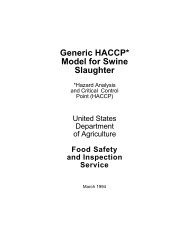Generic HACCP Model for Thermally Processed Commercial
Generic HACCP Model for Thermally Processed Commercial
Generic HACCP Model for Thermally Processed Commercial
Create successful ePaper yourself
Turn your PDF publications into a flip-book with our unique Google optimized e-Paper software.
Introduction<br />
The Hazard Analysis Critical Control Point (<strong>HACCP</strong>) concept is a systematic, scientific<br />
approach to process control. The Food Safety and Inspection Service (FSIS) views <strong>HACCP</strong> as<br />
a means of preventing the occurrence of health and safety hazards in plants producing meat and<br />
poultry and their products. It does this by ensuring that controls are applied at any point in a food<br />
production system where hazardous situations could occur. These hazards may include<br />
biological, chemical, or physical adulteration of food products.<br />
The United States Department of Agriculture (USDA) published a final rule in July 1996<br />
mandating that <strong>HACCP</strong> be implemented as the system of process control in all USDA-inspected<br />
meat and poultry plants. As part of its ef<strong>for</strong>t to assist establishments in the preparation of<br />
plant-specific <strong>HACCP</strong> plans, FSIS determined that a generic model <strong>for</strong> each process defined in<br />
the regulation will be made available <strong>for</strong> use by the regulated industry.<br />
In addition to the generic model, background in<strong>for</strong>mation on <strong>HACCP</strong> is included to assist<br />
an establishment in conducting a hazard analysis and developing a plant-specific plan.<br />
The regulation includes specific references to the development and maintenance of<br />
standard operating procedures <strong>for</strong> sanitation, and these standard operating procedures should be<br />
in place be<strong>for</strong>e a <strong>HACCP</strong> system is implemented. For this reason, principles of good sanitation<br />
are not included as part of the <strong>HACCP</strong> plan.<br />
Principles of <strong>HACCP</strong><br />
The foundation of <strong>HACCP</strong> can be found in the seven principles that describe its functions.<br />
These seven principles are:<br />
Principle No. 1: Conduct a Hazard Analysis. Prepare a list of steps in the process where<br />
significant hazards occur, and describe the preventive measures.<br />
Principle No. 2: Identify the Critical Control Points (CCP's) in the process.<br />
Principle No. 3: Establish critical limits <strong>for</strong> preventive measures associated with each<br />
identified CCP.<br />
Principle No. 4: Establish CCP monitoring requirements. Establish procedures <strong>for</strong> using<br />
the results of monitoring to adjust the process and maintain control.<br />
Principle No. 5: Establish corrective action to be taken when monitoring indicates that<br />
there is a deviation from an established critical limit.<br />
1



